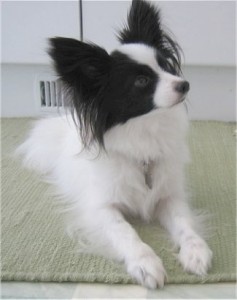 The Papillon, also referred to as the Epagneul Nain and the Continental Toy Spaniel, is a toy breed that originated in France. This breed can be traced back to at least the 14th century. Today this breed is exclusively used as a pet.
The Papillon, also referred to as the Epagneul Nain and the Continental Toy Spaniel, is a toy breed that originated in France. This breed can be traced back to at least the 14th century. Today this breed is exclusively used as a pet.
The Papillon is a toy breed that stands between 8 and 11 inches tall and weighs between 3 and 9 pounds. They have no undercoat and their overcoat is long and silky. They come is several color combinations including lemon and white, white and red, chestnuts, mahoganies, black and white, and tricolored.
The Papillon can have problems with excessive barking and dominance. When training be firm but fair and teach the dog from a young age that you are the leader of the home.
The Papillion is commonly referred as the “butterfly dog” because of their butterfly like ears. They are small, cute, and lively and they are friendly and intelligent dogs that are vivacious and charming.
Origin of the Papillon
The Papillon, also called the Continental Toy Spaniel, is one of the oldest of the toy Spaniels. In the 16th and 17th centuries, were known as Dwarf Spaniels. Papillons were often depicted on the laps of French and Spanish noblewomen.
Their ears were used to be droopy but over time, an erect-eared type, with fringe that resembles the wings of a butterfly, developed. Now, there are two types of such dogs, the Papillons (erect-eared) and the Phalenes (drop-eared). In the United States, they can be born in the same litter and are shown together as one breed.
Appearance and Abilities of the Papillon
The Papillon is a small, friendly, elegant toy dog. It is light and dainty with a fine boned structure. It is distinguished from other breeds by its beautiful, butterfly-like ears. Its eyes are dark and round but not bulging. It has a natural alert expression.
Their heights at the withers are about 8 to 11 inches. Its weight is in proportion to its height. Their gaits are free, quick, easy, and graceful. They are not paddle-footed, or stiff in their hip movements.
The coat is long, silky, flowing, and straight with resilient quality and they have a profuse frill on their chests. Papillons have no undercoat. The breed must be either particolored or white with patches of any color. The tail is long, plumed and carried curled over the back.
Papillon Temperament and Tendencies
The Papillions are happy and alert little dogs that are not usually shy or aggressive. Lively and playful, they are always fun to be around. Although small and cute, they are tougher than they look. They are energetic but can also be calm, patient, gentle, and dignified.
They love to be cuddled and thrive on human companionship. Their obedience and highly trainable traits make them good comfort pets. They do not excessively bark unless they sense danger.
Training and Care of the Papillon
Papillons are very easy to train. They love to play tricks and obey commands. They can be socialized to get along well with other animals, including cats.
Like most small dogs, they are difficult to house train especially during their young age mainly because of poor bladder control. Make sure to be consistent about appropriate places to relieve oneself.
Do not let the dogs become pack leaders to humans. They will have a tendency to become possessive of its owners. When you allow Papillons to take the alpha role, they can develop the “small dog syndrome” which can cause a varying degree of behavior problems such as, being nervous, high-strung, timid, having separation anxiety, over guarding, unexpected growling, snapping, or biting, obsessive barking, dog aggression and being untrustworthy with children.
Papillons can be happy in any living conditions. Whether living in an apartment, out in the country or anywhere in between, they will do just fine. They love to play outdoors but they can be easily entertained and exercised indoors as well.
Grooming is easy because they do not have an undercoat.








5 Responses to “How to Train a Papillon”
We just adopted a 4 yr old papillon. He is my 10 year old daughters pet. Yesterday when she knelt down close to him,he bit her chin. Tonight she went to her room and he chased her out of the room growlilng and barking.
What should we do?
First off, the dog is not the pet of your 10 year old. In fact, I’ve written an entire article on the subject- https://www.dogbehavioronline.com/10-year-old-kids-dont-own-dogs/
That is your biggest and main mistake. Your putting a 10 year old in charge of a dog who has no capacity for showing leadership, who is handling the dog in a way that makes the dog feel threatened, etc.
You, as parents, need to take control of the dog and the entire situation. You need to be responsible for the training and care and your child is welcome to help but it needs to be more of a 90/10 proposition with 90% being yours and 10% being the child’s responsibility.
we just got a papillon yesterday. he is really shy but is great outside. he is beginning to get used to his new home. is there anything i can do to make him less shy and afraid? also i was trying to leash train him. he does follow me but when i put the leash on him he begins to bite it and goes nowhere. i cant use treats to train him as he is not food motivate. he doesnt go for toys either. what should i do to leash train him
i had my baby euthanized for health isues so my granddaughter prought me her 1yr old papillon because she couldnt be home with him like she should and he took right to me… but when we walk with the leash he pulls and pulls… how can i get him to stop doing that… ?
Sign up for our free mini-course offered in the upper right hand corner of every page. One of the videos you’ll get is about leash walking.